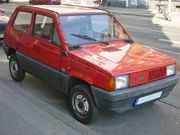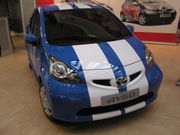City car
Car Show
City car
 The Fiat "Panda," early city car
The Fiat "Panda," early city car
 A current model Toyota city car
A current model Toyota city car
A City Car is a small, moderately powered vehicle (sometimes
battery electric powered) intended for use in urban areas. It is more
substantial and faster than a
Neigborhood Electric Vehicle (NEV). Unlike the NEV, the City Car's greater
speed and occupant protection allow relatively safe operation in mixed traffic
environments and in all weather conditions. While it may be capable of freeway
speeds and may be legal to operate on high speed roadways this is not intended
to be its primary operating environment.
Another name for city car is Station Car, where the intended use is to
travel from a suburban home to an interurban transit station or
Park
and Ride lot where the vehicle remains until the operator returns from the
commute to and from the workplace. In some locations electric vehicle recharging
is provided to encourage the use of electric vehicles. NEVs may also be used as
station cars where the roadway speed limits permit such use.
Internal combustion engine (ICE) city cars
Early
superminis can be considered city cars because of their size, but even in
the late 70s superminis were the second smallest available cars (after the
two-seater
microcars). But in the late 80s they had grown so much that peple desired
smaller cars, which still had to have seating for four.
Early ages
The first city car is probably the
1980
Fiat/SEAT
Panda. With a length under 3.50 metres and low-cost design, a new
car category was created. The Panda remplacement, the 1991
Fiat Cinquecento is unarguably a city car. With only 3.20 meters long,
it had room for four and true entry-level prices.
Renault followed in 1993
with the
Renault Twingo, which featured a
MPV-like design and interior room, despite its size and height (3.43 x 1.42
m). Combined with an original exterior and interior design, it became the
best-selling city car quickly.
Korean vs. European city cars
The Korean brands Daewoo, Hyundai and Kia introduced in the late 90s their
own city cars, both for the Asian and European
markets. The
Hyundai
Atos, launched in
1997, was 3.50 m
long and 1.60 m tall, which was much more than any European models (usually
under 1.45 m) and provided an inmense interior room. However, its boxy styling
prevented the Atos from becoming a best-seller.
The
Daewoo
Matiz followed in
1998 with a Giorgetto Giugiaro design and a mid-size heigth (1.50 m), which proved more
eye-catching. Hyundai tried to revert this with the rounder Atos Prime
but without much success.
These Korean city cars were much cheaper than most of the European models,
specially the 2000
Opel
Agila and 1999
Volkswagen Lupo, and showed decent reliability. Still, sales were
dominated by the
Renault Twingo and
Ford Ka.
Luxury city cars
Mercedes-Benz launched in 1996 the first
luxury
city car, the
Mercedes-Benz A-Class. Despite its true qualities, it was extremely
expensive (it could be compared with the small
family car
Volkswagen Golf) and was not very successful. However
BMW decided to compete against its eternal rival by launching an all-new MINI in
2001. It was
powered by 1.6 engines and the cheapest model in the range cost Ä16,000.
City car / supermini crossovers
While
family cars and
superminis
grew considerably from the 90s to the 2000s, so happened with city cars. After
some new superminis were over 3.90 m long (like the Ford Fiesta, the SEAT Ibiza
and the Volkswagen Polo) some many makers designed models between 3.65 and 3.75 m.
The first of these models was the
2002 Nissan Micra, which is 3.72 m long and smaller that many superminis of the
late 90s. Other cars are the CitroŽn C2, Suzuki Swift, Smart Forfour, Toyota
Yaris and Peugeot 1007 (the last one which can also be labelled as "mini
MPV").
These vehicles are hard to classify, since their size does not fit the "city
car" and "supermini" categories. A possiblity is to compare the price and
interior room with superminis: the Yaris is definitely a supermini, whereas the Tata
Indica is closer to a city car.
In addition, there are new "true" city cars, like the
2004
Kia
Picanto and the
CitroŽn C1/Peugeot
107/Toyota
Aygo trio.
Battery electric city cars
The Th!nk City, imported to the USA by Ford Motor Company to satisfy
California Zero-emissions vehicle (ZEV) requirements in the state of California.
Removed from the market by Ford in a bargain with the California Air Resources
Board..
The REVA electric vehicle as used in its home environment, India. This may
soon be exported to the USA with speed electronically limited and sold as an
NEV.
The obstacle to adaptation of such vehicles in the United States is less
technical than cultural and political. The mandates by regulatory powers that
such vehicles to meet full U.S. safety regulations, as high-speed roadways exist
in most urban and suburban areas, ensures the unavailability of vehicles
suitable for use in mixed traffic conditions that predominate in U.S. suburban
areas. To supporters of electric vehicles this appears not to be an accident.
See also
Home | Up | City car | Supermini car | Subcompact cars | Family car | Compact car
Car Show, made by MultiMedia | Free content and software
This guide is licensed under the GNU
Free Documentation License. It uses material from the Wikipedia.
|







